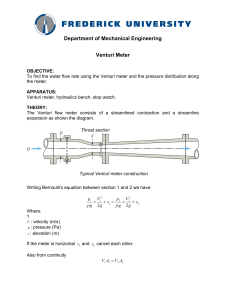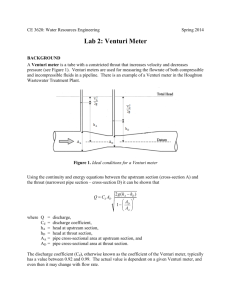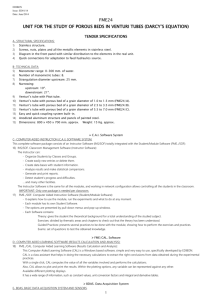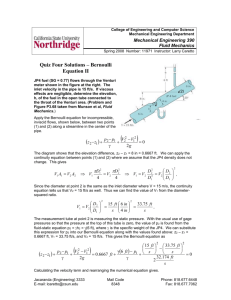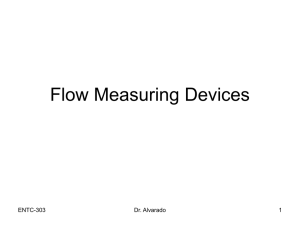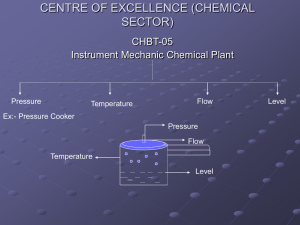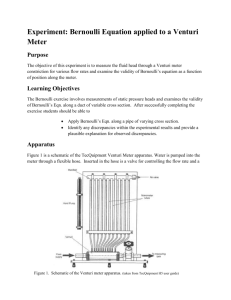Flow Lab
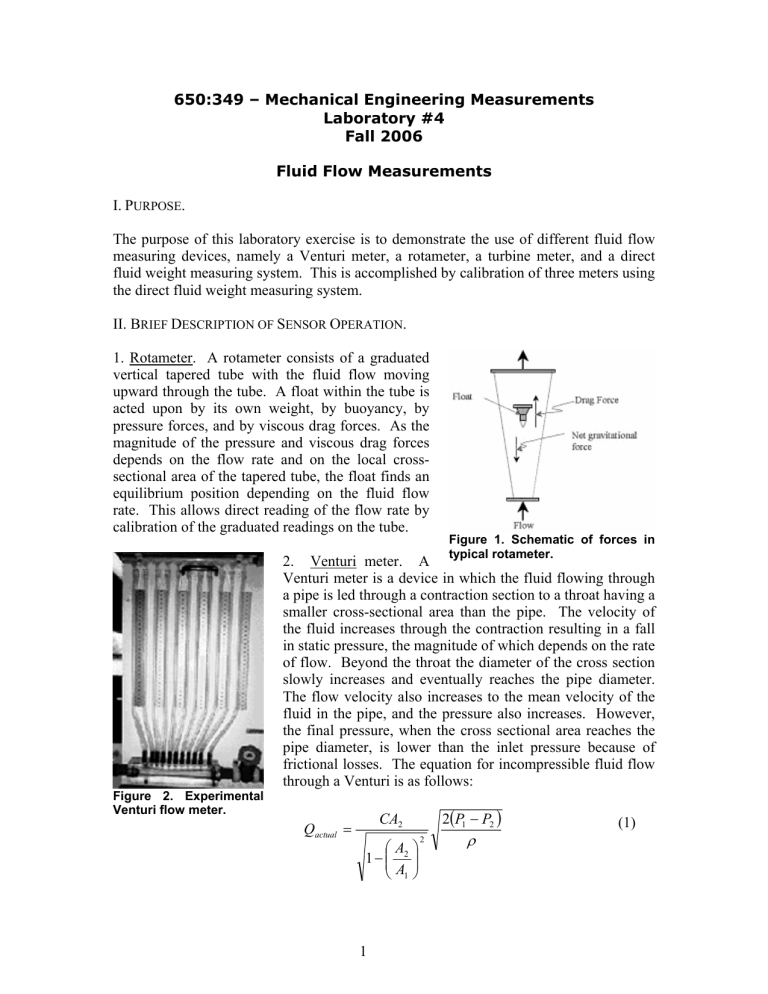
650:349 – Mechanical Engineering Measurements
Laboratory #4
Fall 2006
Fluid Flow Measurements
I.
P URPOSE .
The purpose of this laboratory exercise is to demonstrate the use of different fluid flow measuring devices, namely a Venturi meter, a rotameter, a turbine meter, and a direct fluid weight measuring system. This is accomplished by calibration of three meters using the direct fluid weight measuring system.
II. B RIEF D ESCRIPTION OF S ENSOR O PERATION .
1. Rotameter. A rotameter consists of a graduated vertical tapered tube with the fluid flow moving upward through the tube. A float within the tube is acted upon by its own weight, by buoyancy, by pressure forces, and by viscous drag forces. As the magnitude of the pressure and viscous drag forces depends on the flow rate and on the local crosssectional area of the tapered tube, the float finds an equilibrium position depending on the fluid flow rate. This allows direct reading of the flow rate by calibration of the graduated readings on the tube.
Figure 1. Schematic of forces in typical rotameter.
2. Venturi meter. A
Venturi meter is a device in which the fluid flowing through a pipe is led through a contraction section to a throat having a smaller cross-sectional area than the pipe. The velocity of the fluid increases through the contraction resulting in a fall in static pressure, the magnitude of which depends on the rate of flow. Beyond the throat the diameter of the cross section slowly increases and eventually reaches the pipe diameter.
The flow velocity also increases to the mean velocity of the fluid in the pipe, and the pressure also increases. However, the final pressure, when the cross sectional area reaches the pipe diameter, is lower than the inlet pressure because of
Figure 2. Experimental
Venturi flow meter. frictional losses. The equation for incompressible fluid flow through a Venturi is as follows:
Q actual
=
CA
2
1
−
⎛
⎜⎜
A
2
A
1
⎞
⎟⎟
2
2
(
P
1
ρ
−
P
2
)
(1)
1
Where:
•
Q actual
is the actual flow rate.
•
A
1 and A
2
are two cross sectional areas, normally taken as the pipe and throat areas, respectively
• P
1
and P
2
are the static pressures at the positions for A
1 and A
2.
• ρ is the fluid density
•
C is the discharge coefficient.
3. Turbine meter. The turbine meter is a device which is connected in series with the pipe through which the fluid is moving.
In the specific sensor used, the fluid is made to pass through a series of vanes directing the flow onto a blade rotor causing the rotor to spin. The rotor is designed to rotate on a fluid bearing developed
Figure 4. Streamlines and control volume associated with Venturi tube by the motion, thus eliminating potential bearing wear. An infrared electro-optical transmitter and receiver are molded into the body of the meter. As the moving blade interrupts the infrared beam to the receiver, it produces a voltage pulse whose frequency is proportional to the frequency of rotor motion. Calibration of the number of pulses measured per unit time at different flow rates provides a means of fluid flow measurement. In practice the number of pulses per unit time is registered using a specially calibrated meter which reads fluid flow rate directly. In the present experiment, the number of pulses per second will be monitored using the frequency measuring capabilities of our digital oscilloscope.
4. Direct Measurement. Using a water collection force balance and stopwatch, the actual flowrate can be determined.
III. EQUIPMENT. a. Fluid flow bench with pump, scale and calibrated weights for measuring the water flow rate from the time elapsed for filling a tank with a known mass of water. b. Stop watch. c. Venturi meter equipped with flow
Figure 5. Cutaway of a turbine meter
2
control valve and pressure taps and water manometers for measuring the static pressure. d. Rotameter connected in series with the Venturi. e. Turbine meter also connected in series with the Venturi. f. Oscilloscope for measuring the voltage pulse rate produced by the turbine meter. g. DC power supply for the turbine meter.
IV. PROCEDURE.
1) Flow Meters a. Connect the turbine meter output (co-axial cable) to the oscilloscope. Connect the red and black leads from the turbine meter to the positive and negative terminals, respectively, of a DC Power supply with a voltage between 5-18 Volts. b. Make sure that the valve downstream from the Venturi is fully open. Start the fluid flow bench pump by flipping the toggle switch located on the front of the bench. Allow the pump to flow for 2-3 minutes to get bubbles out of the system. c. Slowly close the valve downstream from the Venturi and allow water pressure to build up through the system. Reduce the flowrate to 2.5 gal per minute using the valve (use the rotameter to judge the flow rate). This helps get bubbles out of the manometer measuring system. d. Set the flow to 6.5 gal per minute using the valve. Adjust the air pressure on top of the manometer bank in order to make the manometers usable at all flow rates (i.e. the lowest pressure in the Venturi tube should be just visible on the manometer scale). [Please have the TA supervise this step]. e. Use the weighing technique (as described by the TA) for measuring the flow rate through the system. Time the accumulation of liquid into the weighing tank of the bench using the stopwatch. First measure the time is takes for just the simple hanger. Then add the two weights (~ 5 kg) and measure the time. Subtract the two times for your measurement. f. Record the rotameter reading and the frequency (pulses/second) using the oscilloscope. g. Record the manometer readings for each position along the Venturi meter. h. Repeat steps e-g for five flow rates between the max (~6.5 GPM) and min possible (~
2.5 GPM).
V. CALCULATIONS AND RESULTS.
3
a. Bucket Measurement. Take your two time measurements, one with the hanger and one with the two weights and subtract the two. The bucket is on a mechanical advantage balance such that the effective weight of the mass is three times its actual mass (due to the position of the fulcrum). Thus, the difference in times is the time is took the bucket to fill up with ~ 15 kg of water. Convert this to gallons per minute. a. Rotameter. Gives information on a direct reading scale in gallons per minute. b. Turbine meter. Convert frequency (f) to volume flowrate (gal/min) using information from product specification sheet Æ 1200 pulses = 1 liter. 1 gal = 3.76 liters.
Q
= f
1200
×
60 sec
1 miute
×
1 gallon
3 .
76 liters c. Venturi Meter.
Compute the pressure drop distribution, (P
A
-P i
), for ideal flow vs. distance along the Venturi. P
A
is the upstream tap pressure and P i
is the pressure at each of the downstream taps. (You can obtain the ideal pressure drop at each manometer tap by rearranging Equation (1) and setting C=1 for ideal flow and solving for the pressure difference). Compare the ideal pressure drop versus the recorded pressure drop. Your plot should look something like the "Relative pressure drop" plot versus distance shown below.
0
-0.2
-0.4
-0.6
-0.8
-1
-1.2
-1.4
-1.6
Ideal Venturi
Real Venturi
-1.8
-2
0 50 100 150
Distance (mm)
Figure 6. Relative pressure drop versus Venturi tube distance for a nominal 6.5 gal/min flowrate.
You can also calculate the head loss for the Venturi tube using the change in pressure between the Venturi inlet and outlet.
4
Head losss h
L
=
Δ
ρ
P g where:
Δ
P = P
A
-P
L
[Pa] (positions from table 1)
ρ
= density of water [kg/m3] g = 9.81 [m/sec2]
You can also calculate the discharge coefficient of your Venturi tube using the definition:
C
=
Q actual
A
D
1
−
⎛
⎜⎜
A
D
A
A
2
(
P
A
ρ
−
P
D
⎞
⎟⎟
2
)
=
Q actual
Q ideal
[2] where D is the location of the throat of the Venturi and Q ideal
is that measured using the weighing technique and Q actual
is the measured using the pressure drop between points A and D.
The following table gives the inside diameter of the Venturi at each manometer tap.
Table 1. Geometrical Specification of Venturi Tube
Tap Location Distance Diameter Area m
2
Items you may want to include:
•
Calibration of turbine meter with actual flow rate (i.e. bucket measurement)
•
Calibration of rotameter with actual flow rate
•
Permanent head loss of Venturi tube (P
L
– P
A
) vs. actual flow rate.
•
Venturi tube discharge coefficient (C) vs. actual flow rate
•
Discharge coefficient vs. indicated pressure drop at throat (P
A
– P
D
).
•
Ideal and actual pressure distribution along Venturi tube for several flow rates
5
•
Estimation of error sources and their effects on your results
•
Discharge coefficient versus Venturi inlet Reynolds number
VI.
REPORTS.
This report should have the format as described in the class guidelines described online:
General Guidelines in Section 2 of the general guidelines.
IMPORTANT:
The Laboratory reports are LIMITED to FOUR PAGES! ANY MATERIAL presented on additional pages will not be considered part of the report. Laboratory reports may contain a maximum of 5 FIGURES and 2 TABLES ! What you include in these figures/tables is your choice; however, use the lab handout and class lecture notes as your guide to determine what the most important measurements you’ve made are. Then create figures which best describe and present the data you have collected as well as support your conclusions.
6
